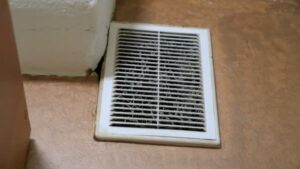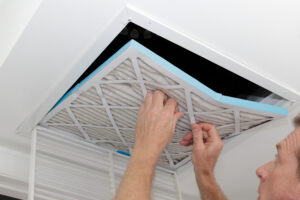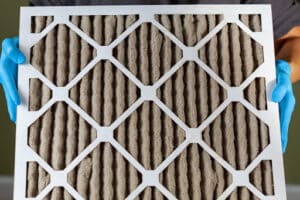How to Choose the Right Air Duct Filter for Your Home
Your air duct filter is an important part of your HVAC system. It’s the barrier that traps airborne particles, stopping them from circulating into your home and improving indoor air quality. While the air quality in the San Francisco Bay Area is generally good, with a clean air filter, your system will filter out dust, allergens, mold spores, and more, keeping you and your family healthier.
Air duct filter replacement is a simple solution to maintaining good indoor air quality in your home and keeping your heat and air conditioning system running with better efficiency. Trio Heating & Air Conditioning provides filter replacement, along with a wide range of heating and cooling system maintenance services to keep your system running smoothly year-round.
Read on to learn more about what air filters are, what they do, and how to find the right filter for your system.

Why Your Air Duct Filter Matters
Your air duct filter stands between you and harmful particulates, filtering dust, dander, pollutants, hair, and allergens from the air you breathe. This helps prevent health issues like allergy symptoms, dry or itchy eyes, headaches, throat irritation, and respiratory problems. The US Environmental Protection Agency (EPA) notes that if you have small children, pets, smokers, elderly folk, or people with allergies or breathing issues in your house, a clean filter is extremely important.
A good HVAC filter will keep your air clear and keep your system running efficiently. The more buildup inside the duct filter, the harder the system has to work. That’s why regular tune-ups are important — they’ll keep your heating and cooling working well and extend the life of the entire system.
Types of Air Duct Filters and Their Benefits
With so many filter types to choose from, how do you know which are the best air filters for your home? The answer depends on the type of HVAC system you have. These are the most commonly used residential air duct filters.
Fiberglass Flat Filters
Commonly found in forced air furnaces, these filters are used to capture large particles before they get into the crucial components of your HVAC system, but they aren’t effective at filtering out microscopic particulates.
Extended Media Filters
These 8-inch-thick stacked filters have pleated cotton or polyester folds to catch smaller air contaminants. They have to be professionally installed as they go inside a specialized filter holder in your ductwork.
Electrostatic Filters
Electrostatic filters create static electricity to make trapping particles easier. The electricity generated acts like a magnet and catches very small particles, including smoke and allergens. These filters don’t need replacement, but they do need to be cleaned every few months using soap and water.
Electronic Filters
These high-tech mechanical filters are plugged into an outlet so they can produce a high-voltage charge generated by a transformer. They’re highly effective at filtering out small particles. It’s important to check the safety rating on your electronic filter before purchasing to make sure they don’t generate ozone, a safety hazard.
High-Efficiency Particulate Air (HEPA) Filters
HEPA filters are pleated mechanical high-efficiency air filters that remove 99.97% of contaminants from the air, including pollen, mold spores, smoke particles, bacteria, and other tiny particles with a size of 0.3 microns.
Ultraviolet (UV) Filters
These are short-wave ultraviolet lights built into the HVAC system to kill microorganisms like bacteria and viruses. These types of filters should be used in conjunction with another type, as they don’t stop dust, hair, or any other particulates.
Gas-phase Filters
This type of filter is uncommon but sometimes used in homes as an add-on to an existing filtration system. They use gas sorption to attract gas molecules to a solid surface, removing odors and volatile organic compounds (VOCs) like ethanol, benzene, or methylene chloride. These filters have a short lifespan and must be replaced frequently.

Understanding MERV Ratings and What They Mean
Minimum Efficiency Reporting Values, or MERVs, are the metrics used to measure an air filter’s capability for capturing particles between 0.3 and 10 microns. By looking at MERV ratings for air filters, you can easily compare different filters and their abilities. If the filter has a higher MERV rating, it’ll be better at trapping particles than one with a lower rating.
Filters rated MERV 1-4 have a simple, basic design and will capture large dust and pollen particles. Those with a rating between 5 and 10 can catch mold spores and dust mites, while 11-12 means the filter will stop pet dander and smoke particles, making them better for homes with pets or those living with allergies or respiratory issues. Even higher MERV ratings will capture bacteria and the smallest particles nd are used in hospitals, clean rooms, and laboratories.
How To Choose the Right Filter for Your Home
Choosing the right HVAC filter is important to keeping your indoor air clean and fresh and your heating and cooling system running efficiently. You’ll have to consider your unique household needs and the types of filters that are compatible with your HVAC setup. If you’re not sure, call Trio Heating & Air. We’ll send an expert technician to look at your system and replace the filters for you.
How Often Should You Replace Your Air Duct Filter?
Each type of filter will have manufacturer recommendations for HVAC filter replacement timing, but generally speaking, you should clean or replace the filter when it looks visibly dirty, when you notice allergy symptoms or excess dust in your home, or after 90 days, whichever comes first. The Bay Area isn’t necessarily a dusty place, but the outdoor air quality varies, especially during wildfire season, so you may need to check your filters more often than the manufacturer's suggestion.

Call Trio Heating & Air Today
Contact Trio Heating & Air for all your HVAC questions, concerns, and service needs. We offer everything from a simple filter change to a full system overhaul. We serve the Greater San Francisco Bay Area, including San Jose, Santa Clara, Walnut Creek, Los Altos Hills, San Ramon, and Sunnyvale, CA. Book online or call us today.
